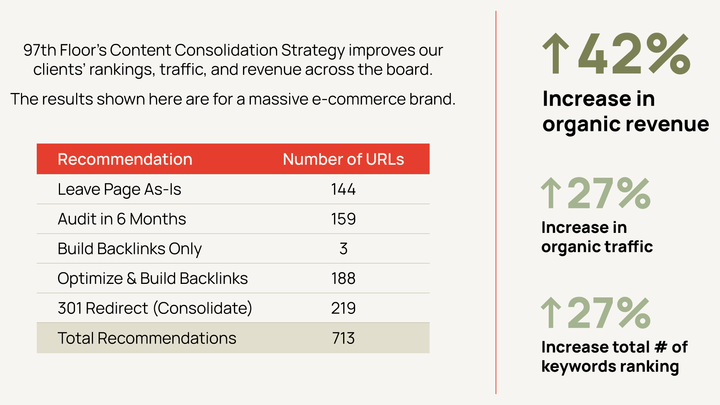Unburden your site of low-value content and watch your SEO performance skyrocket
Content production exploded last year thanks to AI tools, and many of us jumped on board. More content meant more chances to rank, right? Well, it's 2025 now, and the game has changed dramatically.
We're seeing reputable sites hit with serious penalties. Google's quality guidelines are actively flagging AI-generated content, and some organizations are losing millions of monthly sessions. Meanwhile, Google continues tightening crawl budgets across the board.
If your SEO efforts aren't delivering results despite investing in content, you're not alone. The solution may not be creating more content, but strategically consolidating what you already have.
One of the most common misconceptions we hear from clients is that low-performing pages aren't hurting anything. "They're just sitting there," people tell us. "Why bother removing them?"
Mike Witham, our Head of SEO at 97th Floor, explains it this way: "If Google finds a pattern of low-quality content on your site, it will devalue all content and will even stop crawling and indexing your site if the offense is large enough."
Think about it like this: If your site has 100 articles and only 20 are truly excellent while 80 are mediocre, those 80 pages are actively dragging down your entire site's performance. Google has become remarkably good at identifying these quality patterns, and when it spots too many low-value pages, it begins questioning everything you publish.
Your site would benefit from a content consolidation audit if:
✅ Your SEO efforts aren't delivering the expected results
✅ Recent Google updates have hurt your rankings
✅ You're planning a site migration or merge
✅ Your legacy site has been managed by multiple content teams over the years
✅ Too many pages are stuck in "crawled, not indexed" limbo
This approach is particularly valuable for established sites with extensive content libraries. What worked under previous Google algorithms may now be actively hindering your performance.
One of our e-commerce clients came to us with strong technical SEO but declining traffic. After implementing our Content Consolidation Audit recommendations, they saw a 20% increase in ranking keywords, 27% more organic traffic, and—most importantly—a 42% jump in organic revenue.

Unburden your site of low-value content and watch your SEO performance skyrocket
The power of this approach lies in its systematic framework for evaluating every indexed page on your site. Here's how it works:
For the e-commerce client mentioned earlier, we identified hundreds of product category pages competing with each other rather than collectively building authority. By consolidating these into stronger category pages and implementing redirect strategies, we transformed their organic performance.
We've seen similar results across industries. A B2B software client had a blog post about industry trends that attracted substantial traffic but had almost no connection to their core offerings. Rather than removing this valuable traffic source, we added strategic internal links to relevant product pages and introduced a targeted lead magnet. Traffic remained steady while lead generation increased by 23%.
For a financial services client, we found several pages with strong traffic and clear business alignment but poor user metrics. By aligning the calls-to-action with user intent, conversion rates improved by 35%.
The Content Consolidation Audit isn't just a one-time fix—it should become part of your ongoing content approach:
In 2025's SEO landscape, quality trumps quantity every time. A focused collection of high-quality, business-aligned content will outperform a sprawling library of mediocre pages.
By directing your crawl budget toward truly valuable pages, you're not just improving your SEO metrics—you're building a content foundation that genuinely serves your users and supports your business goals.
Ready to see what else is possible?

